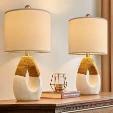Table Lamps That Enhance Ambiance and Functionality

Lighting is the unsung hero of interior design. It has the transformative power to alter the mood of a room, highlight architectural features, and make our daily activities not just possible, but pleasant. While overhead lights provide essential general illumination, they often cast harsh shadows and create a flat, uninspiring atmosphere. This is where the table lamp truly shines. Far more than a simple source of light, a well-chosen table lamp is a functional piece of art, a key player in layered lighting design, and the final touch that makes a room feel complete and inviting. This guide will illuminate the path to choosing the perfect table lamps that marries breathtaking style with indispensable functionality for your home.
The Fundamental Principles of Layered Lighting
To understand the critical role of a table lamp, one must first grasp the concept of layered lighting. A well-designed room incorporates three distinct layers of light, each serving a unique purpose and working in harmony to create a balanced and adaptable environment.
The Three Essential Layers of Light
-
Ambient Lighting: This is the general, overarching light that fills a room, replacing natural sunlight after dark. It’s typically provided by ceiling fixtures like pendants, chandeliers, or recessed downlights. While necessary, ambient light alone often lacks depth and can feel sterile.
-
Task Lighting: As the name implies, this layer is dedicated to illuminating specific activities. It provides a concentrated, brighter light to prevent eye strain. This is where table lamps excel, offering focused light for reading, working, crafting, or applying makeup.
-
Accent Lighting: This layer is used for dramatic effect. It’s designed to highlight architectural details, artwork, or plants. While not the primary function of a table lamp, a strategically placed lamp can cast a beautiful glow on a nearby painting or texture, subtly contributing to this layer.
The table lamp is a master of duality, effortlessly serving as both a primary source of task lighting and a secondary source of ambient light, warming up a corner and contributing to the overall glow of a space.
Selecting the Perfect Lamp for Form and Function
Choosing a table lamp is a balancing act between finding a design that complements your decor and one that fulfills its practical lighting duties. Both the base and the shade play equally important roles in this equation.
Choosing a Base That Complements Your Interior Style
The base of the lamp is its personality. It sets the stylistic tone and acts as a decorative object even when the light is off.
-
Modern & Minimalist: Look for clean lines, geometric shapes, and materials like polished chrome, brushed nickel, gloss ceramic, or simple matte black. The design should be sleek and uncluttered.
-
Traditional & Classic: Opt for bases with more ornate details. Think carved wood, crystal, brass with intricate turning, or ceramic urns with classical patterns. These pieces add a sense of history and formal elegance.
-
Industrial: Choose materials like aged brass, blackened steel, iron, or concrete. Exposed bulbs and utilitarian designs are hallmarks of this style.
-
Scandinavian & Rustic: Natural materials are key. Look for light wood tones, white ceramic, woven rattan, or textured stone. These designs feel organic, cosy, and effortlessly inviting.
Understanding the Critical Role of the Lampshade
The shade is the workhorse of the lamp, responsible for diffusing the light, controlling its direction, and preventing glare. Its colour, material, and shape dramatically affect the quality of light emitted.
-
Linen or Cotton: These classic fabrics provide a soft, warm, and evenly diffused glow. They are versatile and work well in almost any setting.
-
Paper or Parchment: Offers a similar soft diffusion to linen, often creating a beautiful, gentle glow that is perfect for creating a calm ambiance.
-
Silk or Shiny Fabric: These materials reflect more light, making them brighter. A lined silk shade will direct light both upwards and downwards, offering a more formal and brighter illumination.
-
Metal or Glass: These are less common for diffusing light and are often used for a specific aesthetic. They can create more direct and focused light patterns.
-
Colour and Opacity: A dark or black-lined shade will direct all the light upwards and downwards, with very little light emitted through the shade itself, reducing glare—ideal for a home office or reading nook. A lighter, unlined shade will glow softly all around, contributing more ambient light to the room.
Strategic Placement for Maximum Impact and Utility
Where you place your lamp is just as important as which one you choose. Proper placement ensures the light is effective for its intended task and enhances the room’s overall layout.
Optimising Light for Key Activities and Rooms
-
Bedside: The height of the lamp is crucial. When seated in bed, the bottom of the lampshade should be at eye level to shield the bulb from direct view and provide clear, glare-free light for reading. A pair of matching lamps on either side of the bed creates symmetry and balance.
-
Living Room Side Table: Place a lamp on a side table next to your primary seating—your sofa or armchair. This creates a perfect pool of light for reading or conversation, making the seating area feel intimate and defined.
-
Home Office Desk: A task lamp here needs to be bright and focused. An adjustable arm is a significant advantage, allowing you to direct light exactly where you need it onto your work without casting shadows from your hands.
-
Entryway Console Table: A lamp in the entryway provides a warm, welcoming first impression for guests. It also offers a functional light for finding keys or checking your appearance before heading out.
The Technical Details: Bulbs, Brightness, and Dimmers
The lamp itself is just the vessel; the bulb is the source. Understanding the technical aspects will ensure your lamp performs perfectly.
Selecting the Right Light Bulb for Your Needs
The era of the incandescent bulb is over, and LED technology now reigns supreme for its energy efficiency and longevity.
-
Colour Temperature (Kelvin): This measures how "warm" or "cool" the light appears.
-
Warm White (2700K-3000K): Mimics the cosy, yellowish glow of old incandescent bulbs. Perfect for living rooms, bedrooms, and anywhere you want to create a relaxing ambiance.
-
Cool White (3500K-4100K): A brighter, whiter light that feels clean and alert. Ideal for kitchens, home offices, and task-oriented spaces.
-
-
Brightness (Lumens): Forget watts, which measure energy use. Look for lumens, which measure light output.
-
For a bedside reading lamp, aim for 400-800 lumens.
-
For a living room side table, 200-500 lumens is often sufficient for ambient light.
-
-
The Power of Dimmers: Installing a plug-in or in-line dimmer switch, or choosing a lamp with a built-in dimmer, is the single best way to maximise a lamp's versatility. It allows you to transition from bright task lighting to soft, mood-setting ambiance with a simple turn of a dial.
Why Choose Orsina for Your Table Lamp?
At Orsina, we believe lighting is the soul of a room. We are a UK-based home furnishings specialist dedicated to helping you create homes that are not only beautiful but also feel truly lived-in and welcoming.
We are committed to offering a curated collection of table lamps that are selected for their design integrity, quality of materials, and functional excellence. We understand that a lamp is a long-term investment in your home's atmosphere, which is why we partner with designers and makers who prioritise craftsmanship. Our expertise allows us to guide you towards the perfect piece that will provide the right light for your activities and complement your unique style.
Our commitment is to provide exceptional service to customers across the UK, from the first spark of inspiration to the moment you switch on your new lamp. We are here to help you illuminate your home with confidence.
Explore our curated collection of table lamps and discover the perfect piece to light up your living space.
Frequently Asked Questions (FAQs)
1. What size should a table lamp be for a bedside table?
A good rule of thumb is that the bottom of the lampshade should be approximately 60-70cm from the top of the mattress. When you are sitting up in bed, this places the shade at eye level, preventing the bare bulb from glaring into your eyes.
2. Can I use a table lamp in a room with no overhead light?
Absolutely. In fact, it's a fantastic design choice. Using multiple table lamps, along with floor lamps, at different points around the room can create a much more inviting and layered atmosphere than a single central ceiling light ever could.
3. How do I clean a fabric lampshade?
The best method is regular maintenance with a lint roller to remove dust. For deeper cleaning, use the low-power attachment on your vacuum cleaner. For spots, gently dab with a slightly damp cloth, but always test an inconspicuous area first.
4. What is the best bulb for a reading lamp?
For reading, you need a brighter, focused light. Choose an LED bulb with a lumen output between 400-800 and a colour temperature in the cool white range (3500K-4100K) to reduce eye strain and help you stay alert.
5. Is it okay to mix and match different lamp styles in one room?
Yes, this can create a curated, collected-over-time look. The key to making it work is to establish a common thread, such as a consistent colour, material (e.g., all brass bases), or shade style to create a sense of cohesion amidst the variety.
- Art
- Causes
- Crafts
- Dance
- Drinks
- Film
- Fitness
- Food
- Games
- Gardening
- Health
- Home
- Literature
- Music
- Networking
- Other
- Party
- Religion
- Shopping
- Sports
- Theater
- Wellness


